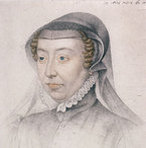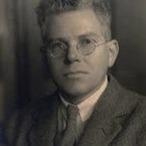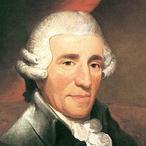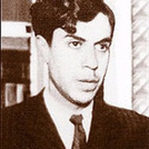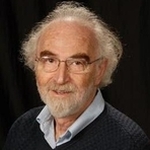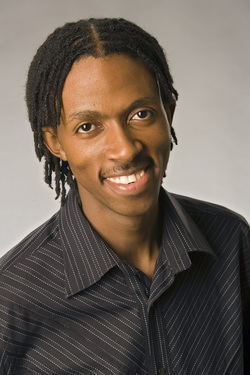 Vuyani Mlinde, bass-baritone Vuyani Mlinde, bass-baritone The latest singer to perform as part of the acclaimed Rosenblatt Recitals series was bass-baritone Vuyani Mlinde. The South African won a full scholarship to the Royal Academy of Music on 2004, and has been going from strength to strength ever since. He has performed roles such as Leporello and Commendatore in Don Giovanni, Sarastro in Die Zauberflöte, and Seneca inL'incoronazione di Poppea. A full biography can be found here. The recital commenced with three Mozart arias. The first, "Se vuol ballare" from Le Nozze di Figaro, was a nice, gentle way to start the evening, leading smoothly to the next offering: "Madamina il catalogo è questo" from Don Giovanni. The last Mozart piece, the concert aria "Così dunque tradisci", was the most impressive in this first section, with Mlinde keeping an even tone throughout the piece, which ranged from D2 to F4. Mozart's calling card in his virtuoso arias is the ascending one and a half octave leap, this time from B2 to F4, which Mlinde navigated with ease. While the Mozart was performed admirably, it was with the Tchaikovsky that Mlinde really came alive. The passion of the Russian composer's work more suited the strong, powerful quality of Mlinde's voice. The second piece, "Gospod’ moj, esli gresen ja", starts with a phrase marked "a piena voce molto espr.", and this was exactly how Mlinde interpreted it. The first phrase, rising and falling like a wave, was imbued with fierce emotion. Towards the end of the aria, his F4 was so full and rounded, he sounded more like a full baritone than a bass-baritone, while the resonance on his unaccompanied F2 was strong, rich and dark.
The next piece was the first of three Verdi opera arias, and for me was the highlight of the evening. Mlinde himself states that Verdi is his "favourite composer", and his performance of Banquo's aria from Macbeth shows just how fully he connects with that composers work. The ominous tone of Mlinde's voice is perfect in first phrases, where Banquo tells his son about the murder of Duncan. At the conclusion of the aria, Mlinde's fortissimo E4 on the phrase "e di terror" rang out through the hall. There was more Verdi to come after the interval, as Mlinde sang Silva's aria from Ernani. There series of three songs by different composers which followed allowed Mlinde to explore a more intimate emotional connection with the audience. Respighi's "Nebbie" was composed during a period of depression, and the music reflects this quality with a repetitious chord rhythm, and long, dark phrases in the vocal line. Mlinde's rich, sombre voice was a perfect vehicle for the melancholic song. The last piece in this set was Gastaldon's "Musica Prohibita". Mlinde was at his most ardent in this last song, as his interpretation of this Neapolitan ballad encompassed both the longing for love, and the seductive qualities of the young, passionate lover. The final aria on the program, "Mentre gonfiarsi l'anima", was again from Verdi, this time from his operaAttila. Mlinde was full of awe and terror in the first half of the aria, his interpretation of the phrase "Di flagellar...il suol!" was particularly moving. The second half of the aria saw Attila back to his normal self, full of fire and rage. Mlinde powered through the lines, ending on a spectacular F4. His encore was the drinking song Im tiefen Keller, performed in English with a translation by John Oxenford. After showcasing his excellent high register, this song focused on his beautiful lower register, with some excellent tone displayed below the stave. It also gave us a chance to enjoy his wonderful sense of humour! Vuyani Mlinde will be performing Beethoven's Symphony No. 9 with the London Symphony Orchestra on tour, and also, in November 2011, the role of Sarastro in Die Zauberflöte for Opera Oviedo. The next season of Rosenblatt Recitalists can be seen here. Please also check out this video about Mlinde and his music.
0 Comments
 Daniil Shtoda, Tenor Daniil Shtoda, Tenor Another fantastic recital at the Wigmore Hall, this time it was with Russian tenor Daniil Shtoda, with an all Russian program. Shtoda began studying the violin at the age of 4, joined the Chorus Institute of the Academic Cappella M.I.Glinka at the age of 6, and made his debut in the role of Feodor in Mussorgsky’s Boris Godunov at the Mariinsky at the age of 13. No wonder he has been described as a "Wunderkind"! Shtoda has benefited from his association with Larissa Gergieva, who accompanied his recital. Gergieva has worked as a coach at such prestigious places as The Met, La Scala and the ROH, and is the Artistic Director of the Mariinsky Academy of Young Singers, where she was Shtoda's teacher. She describes Shtoda as a singer with "a strong personality and a most generous amount of charisma." Here is Gergieva's recollection of the moment she first met Shtoda: "Daniil approached me with a big bouquet of white roses. He was a very young boy with big blue eyes looking for an audition. I asked him what he was going to sing. “Hermann’s aria” – he answered. I thought to myself it was quite a challenge, since Hermann is a very difficult role. I accompanied him at the piano and, after he finished singing Hermann’s aria...I immediately took him to the Academy, which opened a few days later. He has become one of my favourite pupils whom I love to work with." The concert started with three songs by Rimsky-Korsakov, the most beautiful of which was "The Nymph". Gergieva's execution of Rimsky-Korsakov's watery accompaniment was matched perfectly Shtoda's rendering of the sinuous melody. Particularly touching was Shtoda's pianissimo, high in the head voice, on the final phrase: "but the nymph is in the reeds with her plaits loose." This high pianissimo seems to be Shtoda's calling card. The next composer, represented by four songs, was César Cui. In "The Lilacs", Shtoda caresses and moulds the phrases tenderly yet ardently, giving less while making us want more. More subtle still was the dynamic with which Shtoda infused "The statue at Tsarskaya Selo". The rubato on the phrase "the maiden sits eternally sorrowful" was wonderfully performed, Shtoda's singing filled with aching pity.
Rachmaninov was the next offering, and a powerful one it was too! The fire in the short "It cannot be" coruscated through the audience, with both Shtoda and Gergieva filling the Hall with passion. Even more powerful was the introspective "O fair maiden, do not sing before me", from the same opus (#4) as "In the silence of the secret night", which Dmitry Hvorotovsky performed in his Wigmore Hall recital. It's climax is the phrase "I forget, seeing you, but then you sing", reaching its zenith on a fortissimo A4, which Shtoda navigated with ease. It was, however, that high pianissimo, here on a slow chromatic saunter from A4 to C4 at the close of the song, which really took our breath away. After the interval, we were treated to a whole series of songs by Tchaikovsky. In the haunting "Again, as before, I am alone", Shtoda's elegant phrasing eerily shaped the opening piano A minor phrases, while his powerful upper register thundered the progression from E4 to G#4, before returning, pianissimo, to the opening phrases. In "The nightingale", Shtoda's almost conversational phrasing was very moving, while the "Serenade" injected a much welcomed piece of humour. "Amid the noise of the ball" sits lower in the voice, and here Shtoda showed that he is as comfortable in the chest register as he is in the head. The pair gave three encores, in the last of which Shtoda held a very long pianissimo. I shall list them here once I have found out what they are called. Most of the songs from the recital can be found on his album with Gergieva, published on the EMI Classics label. With so much Handel around at the moment, one might think that The Orchestra of the Age of Enlightenment may have made a wrong choice of subject with “A celebration of Handel” at the Queen Elizabeth Hall this season. However, this was most definitely not the case. The program was a perfect mix of music, with contrasting styles, compositional devices, and moods all within the output of a single composer. The effect was to provide an overview of this most prolific of composers, highlighting his abilities within the various modes of Baroque technique. To do this, one must, of course, visit Handel’s operatic and sacred works; and to do this successfully, one must enlist the help of a singer suitably virtuosic in both communication and technique. Elin Manahan-Thomas, (henceforth M-T) soprano, is such a singer. I first became aware of her after hearing her recording of the Birthday Ode to Queen Anne, “Eternal Source of Light Divine”, from her album Eternal Light. I was amazed by the beauty and purity of her voice, particularly in those passages which lay above the stave. The concert, which was being recorded for BBC Radio 3, and will be aired on 19th June, started with the Concerto grosso Op 6, No 1, which was suitably light and entertaining enough to warm everybody up. Next came three of Handel’s most popular arias. First up was “Tornami a vagheggiar” from Alcina. This difficult aria was sung beautifully, with the long, suspended Bb5’s giving me goose bumps as M-T took the vibrato off the note, and sang with the pure tone. Her colour was even throughout the range, and the chest register was lush without resorting to harshness. She was un-phased by Handel’s virtuosic demands. M-T moved from youthful infatuation to the lamentation of freedom lost with the aria “Lascia ch’io pianga” from Rinaldo. The tender phrasing, carried to the end of the line, was convincing, and the final section was haunting, M-T producing some beautifully supported pianissimos. Her immersion into her characters is so complete, that it was difficult to believe that the same singer had just stunned us with the previous aria. The last of the three opera arias was Cleopatra’s “Da tempesta” from Giulio Cesare. M-T was exultant as the Egyptian Queen, firing out the coloratura passages with passion and joy. The energy of the OAE was perfectly matched to M-T’s agility. The next two pieces, straddling the interval, were two Concerto grossi. The first and third movements of Op 3, No 2 were originally used in Handel’s Brockes Passion, a choral work from 1716, but the highlight for me was the beautiful second movement. The Oboe’s lament ebbed and flowed over the two cellos, whose oscillating arpeggios were supported by the excellent continuo. In Op 6, no 7, Handel was at his most inventive. The second movement is an allegro fugue, the subject of which has its foundation in rhythmic variation, repeating the same note for three bars: two minims, four crotchets and eight quavers. It was classily executed, with the viola entrance being particularly powerful. The third movement has a chromatic theme, and the last movement is Handel at his most “English”. The final offering on the program was “Silete venti”, the Cantata for soprano and orchestra. The furious winds conjured up by the OAE were fierce. M-T shone in the final movement, the Alleluia, where she gave full reign to her virtuosity. The encore was Handel’s “Ombra Mai Fu”, from the opera Xerxes. This is a difficult piece to perform, because it is performed so frequently. M-T’s interpretation emphasised tenderness and refinement, focusing on vocal control and pianissimo singing. The penultimate “piu” was held long after the orchestra died away, and was only slightly marred by the spontaneous lighting effects coming from the right of the stage. The concert was truly a celebration of Handel and his music. |
Categories
All
Archives
September 2014
|
MOST VIEWED POSTS
© James Edward Hughes 2013
 RSS Feed
RSS Feed
